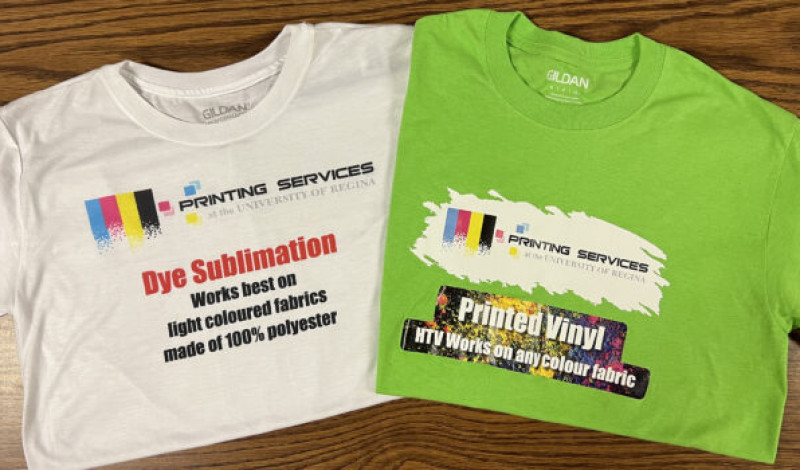An In-Plant’s Success with Apparel Decorating
Meet Judy Peace, the manager at Printing Services, an in-plant for the University of Regina in Saskatchewan, Canada. For those who aren’t familiar with in-plants, these are businesses that operate to fulfill the printing needs of organizations such as hospitals, colleges, and the like.
Printing Services employees seven people. The digital presses onsite include a Kodak Nexpress, Konica C2070, and Konica 6136. They also have an HP316 latex 54” with a cutter for large-format needs. “We are an ancillary department,” adds Peace. “Therefore, we accept external customers, which makes up approximately 40% of our revenue.”
You’ll notice that list doesn’t include apparel decoration equipment, or at least up until 2018, it didn’t. Printing Services made the leap into apparel with the purchase of a Sawgrass SG800 dye-sublimation printer that year.
“We purchased the dye-sublimation equipment in order to produce the university name badges that we had been outsourcing,” explains Peace. “We added other merchandise items at that time to better utilize the equipment. We sell mugs, ornaments, tumblers, slates, coasters, T-shirts, hoodies, aprons, and pillowcases.”
Opening Up Opportunities
While it’s clear the in-plant is using its dye-sub equipment for more than just apparel, Peace notes that thus far, the apparel decorating capabilities it’s opened up are beneficial. “Because dye-sublimation only works well on white or light-colored 100% polyester, we’ve started printing on HTV (heat transfer vinyl), which now allows us to do dark colors and cotton apparel,” she adds. “Since then, we have seen a small growth in garment printing.”
Printing Services is the perfect example of how to make the equipment you already have work with new equipment to explore different opportunities. “Now that we’ve added the printable HTV, I think the garment printing will grow a bit,” Peace states. “We’ve added the printable HTV on our HP316 latex printer because that can be used on dark fabric and any type, so it’s not just limited to 100% polyester. We also do just straight HTV vinyl cutting.”
For Printing Services, there is a very specific niche that adding apparel decorating has helped them fill. “People like the fact that they can come and order one-offs,” says Peace. “It’s convenient for them and more economic for them when they only want a few shirts or one item from the dye-sub merchandise.
“The library orders dark-colored T-shirts for their student staff that just has the wording ‘Library Staff’ on the back. They only order four to six at a time. We just cut these from black HTV. The AV department orders vests for their staff that have their department name on them. This didn’t require any new purchase as it’s utilizing the equipment we already had.”
Some Minor Bumps
But of course, like learning any new technology or process, the team at Printing Services has encountered challenges along the way. While there will always be a learning curve when it comes to training on new equipment, Peace feels that the biggest challenge has to do with supply. “We use a few different suppliers, but it seems that stock is very limited,” she says. “We only order as we need. So for example, when the library orders six dark green shirts and provides the sizes they need, I often have to check out several sources because stock seems so limited since COVID.”
Even as those rippling COVID supply chain issues continue to die down, inventory can still pose a challenge for other reasons. “When ordering merchandise for dye-sublimation, it’s challenging to decide what will be a popular seller and how many to order,” Peace states.
Peace finishes by pointing out that overall, adding apparel decoration to Printing Services’ offerings has been a good thing. “Adding garment printing and other dye-sub merchandise just helped with the ROI on the equipment because now it’s used for more than just name badges,” she says. “We started doing the HTV because again, we didn’t purchase any equipment for it, but we’ve now expanded our ability to do garment printing on dark and cotton fabrics.”

